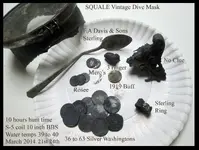reply
I've heard that back when metal detectors first became availalbe to the hobbyists, that old coins, silver, gold, and jewelry was easy picking.
Can some of the folks that hunted back then share some of their experiences? Was it really that easy? Were the parks loaded?
Thanks!
Bryan, your question is much too broad. You've just cited 3 decades (30 yrs.) in your question. And you have to remember that in each 5 yr. span within those decades, was seemingly light-years of advancements, each adding depth, disc, ability in minerals, etc...
and el padron, no one was using mine detectors for coins. At least not WWII mine detectors. They were lucky to find something jar or can sized, and larger. Could not find coin-sized targets.
In the 1960s before discrimination, micky-maguire is right: there was the constant bane of foil and tabs, with which you had no way to discriminate out. I started in about '75 or '76, at the dawn of when discriminators were just starting to be seen in-the-field. I started with an all-metal 66TR. And hunted with a guy using a 77b. So although that wasn't the '60s, yet it was a taste of the tail-end of that earlier generation. We distinctly AVOIDED junky parks (as virgin as they were ), and stuck with cleaner upscale elementary school yards. And to be honest with you, if we got 3 or 4 silvers in a day, we were happy. Because go figure: you'd have to dig foil, and your depth was a whopping 4" if you pushed it. We never thought of hitting exotic stage stops and ghost towns, though now looking back, I kick myself for that. But the reality was, we'd probably have not understood the "relic" mindset, and were more into silver, buffalos, the occasional ring, etc... And although no one had disc. prior to about 1975-ish (so no "gaming of the system", odds, etc...) yet gold rings were NOT that common. The school yards were NOT "brimming" with them. I don't ever recall finding a gold ring with that 66tr. Although my buddy got a few from the schools we hit though.
But to me, the "hey-day" was when motion disc. came out in the very late '70s and into the early '80s. THEN it seemed that silver was easy, and you could effortlessly pass tabs, and still go deep, in junky parks.
I think the "glamour and glory" stories you might read of, where places where someone was the absolute first to hunt under an upside down rollercoast tilt-whirl rides. Or the first person to ever hunt at the base of concession stands, and so forth . Beyond that, I think that the evolution of machines just sort of kept "all things equal".
Example: There was the story of a fellow who was the absolute first person to ever hit a ghost town in Utah. The RR town had had a peak population of a few thousand, but by the '20s, had been abandoned d/t the RR spur bypassed it, or the mines played out, or something. The fellow started detecting it in about 1965 with a transistor-like toy detector. But it could reach coins at up to an inch deep! Woohoo! And his average take for a day's hunt was 2 or 3 coins, in with all the ghost-townsy junk. Fast forward to the later '60s, and he gets a better deeper machine, and goes back through the same areas. On account of more depth, he AGAIN is still averaging "2 to 3 coins per hunt". Fast forward to the early '70s and now he's got more depth. Still though "2 to 3 coins per hunt". Fast forward to the mid and late '70s: now he's got disc, and even MORE depth. Still "2 to 3 coins per hunt". Fast forward to the mid 80's and he's got machines that seen through iron while discriminating AND have depth. Yup. 2 to 3 coins per day.
So you see from that example, that the technology advancements merely kept up with the competition, so-to-speak.
So you'd need to hone down you question to a particular set of years, and a particular type sites. Obviously some parts of the USA didn't see hobbyist detectors till later, and so forth.




